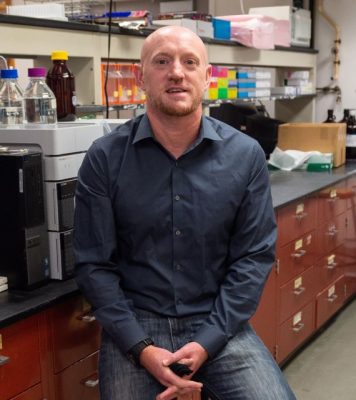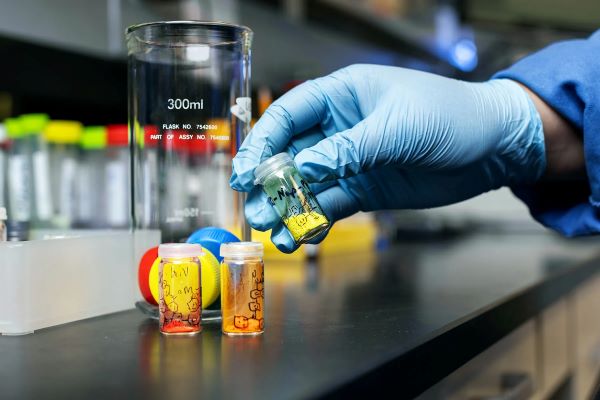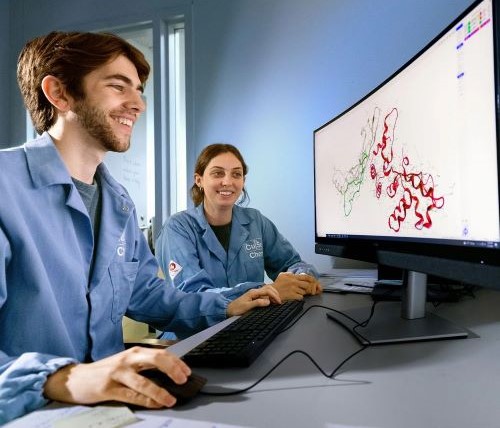Peptide Drug Advances Being Made on Syracuse University Campus Working to Redefine Obesity, Diabetes Care
Over the past 18 months, Robert Doyle, a medicinal chemist and the Jack and Laura H. Milton Professor of Chemistry in the College of Arts and Sciences at Syracuse University, introduced two new peptide compound discoveries at conferences of the American Chemical Society (ACS) and The Obesity Society. He and his collaborators reported that the compounds notably reduce body weight and normalize blood glucose levels without the typical negative side effects experienced by many patients who take currently available GLP-1-based anti-obesity drugs.
Doyle and his fellow researchers have since worked on refining the compounds, GEP44 and KCEM1, and have undertaken lab-animal testing, filed patents, spoken with investors and explored market placement. They believe these drugs, ultimately intended for use in humans, will offer significant advances in how obesity and diabetes are treated in the U.S. and around the world. The researchers have also discovered another highly promising weight-loss compound and new outgrowths that have potential to treat opioid addiction through similar neuroendocrine pathways.
Doyle is also a professor of pharmacology and medicine at SUNY Upstate Medical University. He is working with two primary collaborators on the compounds: Matthew Hayes, Albert J. Stunkard Professor in Psychiatry at the University of Pennsylvania Perelman School of Medicine, and Christian Roth, an endocrinologist at Seattle Children’s Research Institute.

Multiple Receptors
GEP44 consists of 44 amino acids that target receptors in the brain, pancreas and liver simultaneously, uncoupling the connection between food intake and nausea and vomiting. “It’s sort of a reboot of the body’s computer. It’s the sum of those receptors communicating with each other that is facilitating changes to metabolic behavior like what you’d see in a lean person or someone post bariatric surgery,” Doyle says.
GEP44 works very well and is a significant improvement over GLP1-based drugs; however, it requires daily injections—a regimen Doyle acknowledges would be challenging for many patients. That’s why the researchers are working to reformulate the compound as a long-acting version.
“Now, we’re looking at how proteins are changing, what neurons are firing and which genes are changing in response to our drug that aren’t changing in response to the current therapies,” Doyle explains. “We can definitely do a once-a-week injectable, control weight loss, control tolerability as measured by pica (a craving to eat things having no nutritional value). However, we want to create a formulation that has the best tolerability and the highest efficacy before we move into licensing. After all, it is not a trivial thing to take something you’ve optimized to work beautifully well, then go ahead and make it long acting.”
The second compound, KCEM1, was formulated to treat hypothalamic obesity in children, a genetic (as opposed to calorie intake-related) condition. Roth is testing the drug in lab animals and the team is working with the German researchers who discovered the causative gene.
Doyle and Hayes recently produced another “extraordinary compound” that Doyle says is “very exciting and really, really positive for the future.” DG260 targets different mechanisms in the body. In addition to producing weight loss with high drug tolerability and no adverse side effects, it has added health benefits: higher caloric burn and the ability to flush glucose from the blood without needing to increase insulin secretion.
An unexpected outgrowth of this effort has been the team’s discovery that GEP44 reduces cravings in opioid-addicted lab animals, extending the intervals between periods of drug-seeking behavior. This “pleasant surprise” may lead to new therapies to help reduce human cravings for drugs such as fentanyl, Doyle believes. Heath Schmidt, a neuropharmacologist and associate professor of psychiatry at the University of Pennsylvania Perelman School of Medicine, is collaborating with Doyle on this work.
On-Site Lab
All compounds are produced in a campus lab at Syracuse University’s Center for Science and Technology equipped as a sort of mini pharmaceutical design and manufacturing center. It houses three state-of-the-art, microwave-assisted peptide synthesizers and a fourth robotic system, which allows high throughput peptide synthesis of up to 1,200 peptides in the span of three to four days.

“We can get data back, turn it around in days and turn that into a genuine lead in the space of a few weeks. Our setup also lets us manufacture and purify at large scales. That lets us pivot quickly, screen quickly and get back into an in vivo (testing on whole living organisms) setup again quickly. We’re able to operate at a real cutting-edge, rapid-pivoting capability,” Doyle says.
The sophisticated machinery was acquired in part through a $3 million grant awarded in 2019 by the U.S. Department of Defense (DoD) Congressionally Directed Medical Research Programs. The team’s work holds particular promise for military personnel and veterans, for whom obesity and weight-related diabetes rates have steadily increased, according to a white paper from the American Security Project. Those conditions cost the government $135 billion annually and have negative implications for U.S. military readiness, the report states.
“We couldn’t have gotten anywhere near where we are now without that initial DoD grant,” Doyle says. “It’s fantastic that we’ve been able to take this all the way through to patentability, have active engagement with investors, get licensed to an existing company and work this as far forward as we have with hopes of seeing its use in people.”

More recently, the researchers’ work has been awarded four additional National Institutes of Health grants totaling more than $6 million. The projects also provide important experiential laboratory learning for undergraduate and graduate students and cutting-edge research opportunities for postdoctoral associates.
Looking Ahead
When their work began eight years ago, the researchers aimed to make safety and tolerability a front-and-center focus, Doyle says. “We were adamant that nausea, vomiting and indigestion were more of an issue than had previously been put forward. Now, everyone knows that these side effects are a problem and that the existing drugs need to be replaced with ones that are better tolerated. So, the race is on to find new pathways to achieve what we’ve all gotten a taste for—these miraculous weight-loss drugs—and make them effective in the long term.”
Accordingly, Doyle sees a coming explosion in the development of “super safe, super effective weight-loss medicines.”
“The market’s only going to double and triple over the next 20 years. In the next five to 10 years, we may see six, seven, eight new drugs that are well tolerated without the current side effects and that are super long acting. Now, everyone’s racing toward that. We’re trying to drive that forward from Syracuse University and Central New York, and we’ve had a good start.”


